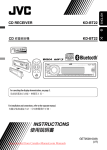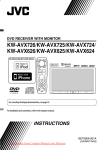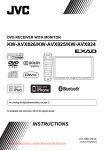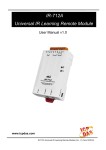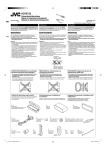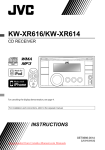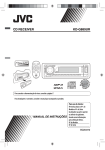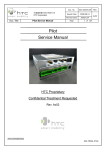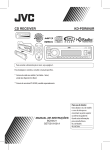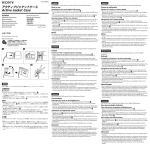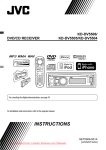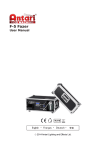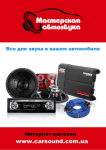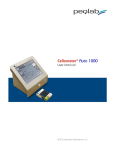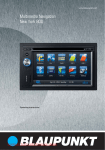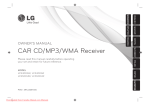Download JVC KD-G845 User Guide Manual - CaRadio
Transcript
KD-G845 KD-G845 For canceling the display demonstration, see page 4. For installation and connections, refer to the separate manual. INSTRUCTIONS GET0498-005A Downloaded from Caradio-Manual.com Manuals [UT] ENGLISH CD RECEIVER ENGLISH Thank you for purchasing a JVC product. Please read all instructions carefully before operation, to ensure your complete understanding and to obtain the best possible performance from the unit. IMPORTANT FOR LASER PRODUCTS 1. CLASS 1 LASER PRODUCT 2. CAUTION: Do not open the top cover. There are no user serviceable parts inside the unit; leave all servicing to qualified service personnel. 3. CAUTION: Visible and/or invisible class 1M laser radiation when open. Do not view directly with optical instruments. 4. REPRODUCTION OF LABEL: CAUTION LABEL, PLACED OUTSIDE THE UNIT. [European Union only] How to use the M MODE and SEL buttons Warning: If you use M MODE or SEL (select), the display and some controls (such as the number buttons, 4 /¢ buttons, 5/∞ buttons, and the control dial) enter the corresponding control mode. If you need to operate the unit while driving, be sure to look around carefully or you may be involved in a traffic accident. Ex.: When you press number button 1 after pressing M MODE, to operate the FM tuner. Caution: If the temperature inside the car is below 0°C, the movement of animation and text scroll will be halted on the display to prevent the display from being blurred. appears on the display. When the temperature increases, and the operating temperature is resumed, these functions will start working again. Caution on volume setting: Digital devices (CD/USB) produce very little noise compared with other sources. Lower the volume before playing these digital sources to avoid damaging the speakers by sudden increase of the output level. To use these controls for original functions, press M MODE again. • However, pressing SEL makes the unit enters a different mode. • Waiting for about 15 seconds (or 30 seconds for Bluetooth sources) without pressing any of these buttons will automatically cancels the control. Downloaded from Caradio-Manual.com Manuals 2 CONTENTS INTRODUCTIONS Preparation .................................................. 4 OPERATIONS Basic operations ........................................... 5 • Your preset adjustments will also be erased (except the registered Bluetooth device, see pages 12 and 13). How to forcibly eject a disc • Using the control panel............................... • Using the remote controller (RM-RK50)...... 5 6 Listening to the radio ................................... 7 Disc operations............................................. 9 Listening to the USB device .......................... 11 EXTERNAL DEVICES Using the Bluetooth ® devices....................... 12 “Please Eject” appears on the display. • Using the Bluetooth cellular phone ............ 14 • Using the Bluetooth audio player ............... 16 Listening to the CD changer ......................... 17 Listening to the iPod .................................... 18 Listening to the other external components.............................................. 20 • Be careful not to drop the disc when it ejects. • If this does not work, reset your unit. SETTINGS Selecting a preset sound mode .................... General settings — PSM .............................. Bluetooth settings ....................................... Title assignment .......................................... 21 23 27 28 REFERENCES More about this unit .................................... Troubleshooting........................................... Maintenance ................................................ Specifications ............................................... 29 33 38 39 For safety... • Do not raise the volume level too much, as this will block outside sounds, making driving dangerous. • Stop the car before performing any complicated operations. Temperature inside the car... If you have parked the car for a long time in hot or cold weather, wait until the temperature in the car becomes normal before operating the unit. Downloaded from Caradio-Manual.com Manuals 3 ENGLISH How to reset your unit ENGLISH Preparation Cancel the display demonstration and set the clock • See also pages 23 and 24. 1 2 Turn on the power. 3 Cancel the display demonstrations Enter the PSM settings. Select “Demo,” then “Off.” Set the clock Select “Clock Hr” (hour), then adjust the hour. Select “Clock Min” (minute), then adjust the minute. Select “24H/12H,” then “24Hours” or “12Hours.” 4 Finish the procedure. Changing the display information and pattern When the power is turned off: Check the current clock time Ex.: When tuner is selected as the source Source operation display • If a station has been assigned a title, station title appears after about 5 seconds. • To assign a title to a station, see page 28. Detaching the control panel Audio level meter display (see “LevelMeter” on page 23) Attaching the control panel Avoid touching the connectors. Downloaded from Caradio-Manual.com Manuals 4 INTRODUCTIONS ENGLISH Basic operations Using the control panel 1 • TUNER: Select preset station. 2 3 4 5 6 7 8 • CD/USB/CD-CH: Select folder. • USB-iPod: Enter the main menu [Hold]. • iPod: Enter the main menu/Pause playback/ Confirm selection. • BT-PHONE/BT-AUDIO: Select a registered device. • Turn on the power. • Turn off the power [Hold]. • Attenuate the sound (if the power is on). Display window USB (Universal Serial Bus) input jack Select the sound mode. Flip down the control panel. • To eject the disc, flip down the control panel then press 0 on the unit. AUX (auxiliary) input jack • TUNER: Search for station. • CD/USB/CD-CH/USB-iPod/iPod: Select track. • BT-AUDIO: Reverse skip/forward skip. 9 • Volume control [Turn]. p q w e r • Select the source [Press] *1. TUNER *2 = CD *2 = USB *2 (or USB-iPod) *2 = CD-CH *2/iPod *2 (or EXT IN) = BT-PHONE *2 = BT-AUDIO *2 = AUX IN = (back to the beginning) • Select/adjust the sound mode. • Enter the PSM settings [Hold]. • TUNER: Select preset station. • CD/USB/CD-CH: Select folder/track/disc (for CD changer). • USB-iPod: Select preset top menu items. • BT-PHONE: Dial preset phone number *3. • Enter functions mode. • BT-PHONE: Activate Voice Dialing [Hold]. Change the display information and pattern. • TUNER: Select the bands. • USB-iPod: Start/pause playback. *1 Holding SOURCE will enter the Bluetooth menu. *2 You cannot select these sources if they are not ready or not connected. *3 For storing preset phone number, see page 16. Downloaded from Caradio-Manual.com Manuals OPERATIONS 5 ENGLISH Using the remote controller (RM-RK50) Installing the lithium coin battery (CR2025) Before using the remote controller: • Aim the remote controller directly at the remote sensor on the unit. • DO NOT expose the remote sensor to bright light (direct sunlight or artificial lighting). 1 • Turns the power on if pressed briefly or Remote sensor Warning (to prevent accidents and damage): • Do not install any battery other than CR2025 or its equivalent. • Do not leave the remote controller in a place (such as dashboards) exposed to direct sunlight for a long time. • Store the battery in a place where children cannot reach. • Do not recharge, short, disassemble, heat the battery, or dispose of it in a fire. • Do not leave the battery with other metallic materials. • Do not poke the battery with tweezers or similar tools. • Wrap the battery with tape and insulate when throwing away or saving it. attenuates the sound when the power is on. Turns the power off if pressed and held. Changes the FM/AM bands with 5 U. Changes the preset stations with D ∞. Changes the folder of the MP3/WMA/WAV. While playing an MP3 disc on an MP3-compatible CD changer: – Changes the disc if pressed briefly. – Changes the folder if pressed and held. • While listening to an Apple iPod: Connected to KS-PD100: – Pauses or resumes playback with D ∞. – Enters the main menu with 5 U. (Now 5 U/D ∞/2 R/F 3 work as the menu selecting buttons.)* * 5 U : Returns to the previous menu. D ∞ : Confirms the selection. Connected to the USB input jack: – Enter the main menu if pressed and held. – Select the desired menu if pressed briefly. – Fast skip in every layer of the main menu if pressed and held. Adjusts the volume level. Selects the sound mode (iEQ: intelligent equalizer). Selects the source. For Bluetooth cellular phone: – Answers calls if pressed briefly. – Rejects calls if pressed and held. • Searches for stations if pressed briefly. • Fast-forwards or reverses the track if pressed and held. • Changes the tracks if pressed briefly. • 2 • • • • 3 4 5 6 7 Downloaded from Caradio-Manual.com Manuals 6 Connected to the USB input jack: – Start play back the selected folder directly if pressed and held. • Reverse skip/forward skip for Bluetooth audio. Listening to the radio 1 Select “TUNER.” 2 3 Select the bands. Search for a station to listen—Auto Search. Manual Search: Hold either one of the buttons until “M” lights up on the display, then press it repeatedly. • When receiving an FM stereo broadcast with sufficient signal strength, lights up on the display. When an FM stereo broadcast is hard to receive FM station automatic presetting —SSM (Strong-station Sequential Memory) 1 You can preset up to six stations for each band. 1 2 While listening to a station... 2 Reception improves, but stereo effect will be lost. lights up on the display. • 3 Exit from the setting. Downloaded from Caradio-Manual.com Manuals Continued on the next page OPERATIONS 7 ENGLISH • While listening to an iPod (in menu selecting mode): Connected to KS-PD100: – Selects an item if pressed briefly. (Then, press D ∞ to confirm the selection.) – Skips 10 items at a time if pressed and held. ENGLISH 3 3 Display the Preset Station List. 4 Select the preset number you want to store into. Local FM stations with the strongest signals are searched and stored automatically in the selected FM band. Manual presetting Ex.: Storing FM station of 92.5 MHz into preset number 4 of the FM1 band. Using the number buttons 1 2 • You can move to the lists of the other FM bands ) or by pressing number button 5 ( 6( ) repeatedly. 5 3 Store the station. Preset number flashes for a while. Listening to the preset station on the Preset Station List Using the Preset Station list • When is shown on the display, you can move back to the previous screen by pressing number button 3. 1 Follow steps 1 and 2 of “Using the number buttons” above. • By holding 5 / ∞, the Preset Station List will also appear (go to step 4). 1 Display the Preset Station List, then select the preset station you want to listen to. 2 Change to the selected station. 2 Downloaded from Caradio-Manual.com Manuals 8 All tracks will be played repeatedly until you change the source or eject the disc. ENGLISH Disc operations To stop play and eject the disc Caution: Make sure to detach the USB device before opening the control panel, as it might block the opening mechanism. • To detach the USB device, see page 11. • Press SOURCE to listen to another playback source. Prohibiting disc ejection To cancel the prohibition, repeat the same procedure. Pressing (or holding) the following buttons allows you to... After pressing M MODE, press the following buttons to... Skip 10 tracks MP3/WMA: Within the same folder [Press] Select track [Hold] Reverse/fast-forward track *1 (Number buttons) *2 Repeat Track: Repeat current track Repeat Folder: MP3/WMA: Repeat current folder MP3/WMA: Select folder Locate particular folder *3 (for MP3/WMA disc) or track directly *1 By holding either one of the buttons, you can display the Folder List (see page 10). *2 Press to select number 1 to 6; hold to select number 7 to 12. *3 It is required that folders be assigned with 2-digit numbers at the beginning of their folder names—01, 02, 03, and so on. Random Folder: MP3/WMA: Randomly play all tracks of current folder, then tracks of next folders Random Disc: Randomly play all tracks • You can also cancel the playback mode by selecting ). “Off” or press number button 4 ( Downloaded from Caradio-Manual.com Manuals Continued on the next page OPERATIONS 9 ENGLISH Selecting a folder/track on the list (only for MP3/WMA file) • When is shown on the display, you can move back to the previous screen by pressing number button 3. 1 2 5 Change to the selected item. A If File List is selected The list disappears and playback starts. B If Folder List is selected Select “LIST.” 3 Select the list type. 4 Select an item. • If the current folder is selected, File List appears, then repeat steps 4 and 5 A to start playback. • If another folder is selected, playback starts from the 1st file of the selected folder. Ex.: When “File” is selected in step 3 • You can move to the other lists by pressing ) or 6 ( ) number button 5 ( repeatedly. Downloaded from Caradio-Manual.com Manuals 10 You can connect a USB mass storage class device such as a USB memory, Digital Audio Player *, portable HDD, etc. to the unit. • You can also connect an Apple iPod to the USB input jack. For details of the operations, see pages 18 and 19. This unit can play MP3/WMA/WMA-DRM10 */WAV tracks stored in a USB device. * You can connect both MTP (Media Transfer Protocol) devices and USB mass storage class devices. See also page 31. All tracks will be played repeatedly until you change the source or detach the USB device. 1 2 USB input jack USB memory If a USB device has been attached... Playback starts from where it has been stopped previously. • If a different USB device is currently attached, playback starts from the beginning. To stop play and detach the USB device Straightly pull it out from the unit. • Press SOURCE to listen to another playback source. You can operate the USB device in the same way you operate the files on a disc. (See pages 9 and 10.) • You can listen to WAV files by following the MP3/ WMA files operations listed on pages 9 and 10. Cautions: • Avoid using the USB device if it might hinder your safety driving. • Do not pull out and attach the USB device repeatedly while “Reading” is shown on the display. • Do not start the car engine if a USB device is connected. • This unit may not be able to play the files depending on the type of USB device. • Operation and power supply may not work as intended for some USB devices. • You cannot connect a computer to the USB input terminal of the unit. • Make sure all important data has been backed up to avoid losing the data. • Do not leave a USB device in the car, expose to direct sunlight, or high temperature to avoid deformation or cause damages to the device. • Some USB devices may not work immediately after you turn on the power. • For more details about USB operations, see pages 30 and 31. Downloaded from Caradio-Manual.com Manuals OPERATIONS 11 ENGLISH Listening to the USB device ENGLISH Using the Bluetooth ® devices For Bluetooth operations, it is required to connect the Bluetooth Adapter (KS-BTA200) to the CD changer jack on the rear of this unit. • Refer also to the instructions supplied with the Bluetooth adapter and the Bluetooth device. • Refer to the list (included in the box) to check the countries where you may use the Bluetooth ® function. To use a Bluetooth device through the unit (“BT-PHONE” and “BT-AUDIO”) for the first time, you need to establish Bluetooth wireless connection between the unit and the device. • Once the connection is established, it is registered in the unit even if you reset your unit. Up to five devices can be registered in total. • Only one device can be connected at a time for each source (“BT-PHONE” and “BT-AUDIO”). Registering a Bluetooth device Registering using “Open” Preparation: Operate the device to turn on its Bluetooth function. 1 Select “BT-PHONE” or “BT-AUDIO.” 2 Select “NEW.” 3 Enter setting menu. 4 Select “Open.” 5 Enter a PIN (Personal Identification Number) code to the unit. • You can enter any number you like (1-digit to 16-digit number). [Initial: 0000] • To enter a PIN code less than 4-digit, firstly delete the initial PIN code (0000) by pressing number button 5 ( ). * Some devices have their own PIN code. Enter the specified PIN code to the unit. 1 Move to the next (or previous) number position. Registration (Pairing) methods Use either of the following items in the Bluetooth menu to register and establish the connection with a device. • Select “BT-PHONE” or “BT-AUDIO” as the source to operate the Bluetooth menu. Open Make the unit ready to establish a new Bluetooth connection. Connection is established by operating the Bluetooth device. Search Make the unit ready to establish a new Bluetooth connection. Connection is established by operating the unit. • When is shown on the display, you can move back to the previous screen by pressing number button 3. Downloaded from Caradio-Manual.com Manuals 12 2 Select a device you want to connect. 3 Repeat steps 1 and 2 until you finish 3 • For available devices... 1 Enter the specific PIN code of the device to the unit. Refer to the instructions supplied with the device to check the PIN code. 2 Use the Bluetooth device to connect. Now connection is established and you can use the device through the unit. entering a PIN code. 4 Confirm the entry. “Open...” flashes on the display. 6 Use the Bluetooth device to search and connect. On the device to be connected, enter the same PIN code you have just entered for this unit. “Connected (and device name)” appears on the display. Now connection is established and you can use the device through the unit. The device remains registered even after you disconnect the device. Use “Connect“ (or activate “Auto Connect”) to connect the same device from next time on. (See the following and pages 27 and 28.) • For special device... Use “Open” or “Search” to connect. Connecting/disconnecting/deleting a registered device 1 Select “BT-PHONE” or “BT-AUDIO.” 2 Select a registered device you want to connect/disconnect/delete. 3 Enter setting menu. 4 • Select “Connect” or “Disconnect” to connect/disconnect the selected device. Connecting a device Perform steps 1 – 3 on page 12, then... 1 • Select “Search” to search for available devices. The unit searches and displays the list of the available devices. If no available device is detected, “Device Not Found” appears. • Select “Special” to connect a special device. The unit displays the list of the preset devices. Downloaded from Caradio-Manual.com Manuals Continued on the next page EXTERNAL DEVICES 13 ENGLISH 2 Select a number or blank space. ENGLISH • Select “Delete,” then confirm the selection. Press number button 3 to select “No” or return to the previous screen. You can set the unit to connect the Bluetooth device automatically when the unit is turned on. (See “Auto Connect” on pages 27 and 28.) Using the Bluetooth cellular phone 1 Select “BT-PHONE.” 2 Enter Bluetooth menu. 3 — Establish the connection with a device, then make a call (or settings using the Bluetooth menu). When a call comes in.... When a text message comes in.... The source is automatically changed to “BT-PHONE.” If the cellular phone is compatible with Text Message and “Message Info” is set to “Auto” (see pages 27 and 28), the unit rings and “Received Message” appears on the display to inform you of the message arrival. When “Auto Answer” is activated.... The unit answers the incoming calls automatically, see pages 27 and 28. • When “Auto Answer” is deactivated, press any /control dial) to answer the button (except incoming call. To end the call Hold any button (except /control dial). • You can adjust the microphone volume level (see pages 27 and 28). Downloaded from Caradio-Manual.com Manuals 14 1 Select “BT-PHONE.” * Displayed only when your cellular phone is equipped with these functions. – If not displayed, try to transfer the phone book memory of the cellular phone to this unit. (Refer to the instruction manual supplied with your cellular phone.) – With some cellular phones, the phone book memory is transferred automatically. 5 2 Enter setting menu. 3 Select “Dial Menu.” Select the name/phone number you want to call. How to enter phone number Select a number. 4 Select the method to make a call. Move the entry position. • Redial *: Shows the list of the phone numbers you have dialed. Go to the following step. • Received *: Shows the list of the received calls. Go to the following step. • Phonebook *: Shows the phone book of the connected cellular phone. Go to the following step. • Missed *: Shows the list of the missed calls. Go to the following step. • Number: Shows the phone number entry screen. See “How to enter phone number” on the right column. • Voice Dial (Only accessible when the connected cellular phone has the voice recognition system): Speak the name (registered words) you want to call. Downloaded from Caradio-Manual.com Manuals Confirm the entry. Continued on the next page EXTERNAL DEVICES 15 ENGLISH Making a call You can make a call using one of the Dial Menu items. • When is shown on the display, you can move back to the previous screen by pressing number button 3. ENGLISH Using voice command 1 2 1 Display the phone number you want to preset by using one of the “Dial Menu” items. 2 Select a phone number. You can also enter a new phone number (see also “How to enter phone number” on page 15) to store. 3 Select a preset number to store. “Say...” appears on the display. Speak the name (registered words) you want to call. • You can also use voice command from the Dial Menu. Select “Voice Dial” from the Dial Menu. • If your cellular phone does not support the voice recognition system, “Error” appears on the display. Presetting the phone number You can preset up to six phone numbers. is shown on the display, you can • When move back to the previous screen by pressing number button 3. To call a preset number While in Bluetooth phone.... Using the Bluetooth audio player • Operations and display indications differ depending on their availability on the connected audio player. Select “BT-AUDIO.” If playback does not start automatically, operate the Bluetooth audio player to start playback. Reverse skip/forward skip Start/pause playback Enter setting menu (Device list) • Refer also to pages 13 and 14 for connecting/ disconnecting/deleting a registered device. Bluetooth Information: If you wish to receive more information about Bluetooth, visit the following JVC web site: <http:// www.jvc-victor.co.jp/english/car/>. Downloaded from Caradio-Manual.com Manuals 16 ENGLISH Listening to the CD changer It is recommended to use a JVC MP3-compatible CD changer with your unit. You can connect a CD changer to the CD changer jack on the rear of the unit. • You can only play conventional CDs (including CD Text) and MP3 discs. Preparation: Make sure “Changer” is selected for the external input setting, see page 25. 1 Select “CD-CH.” 2 Select a disc to start playing. [Press] For selecting disc number 1 – 6. [Hold] For selecting disc number 7 – 12. [Press] Select track [Hold] Reverse/fast-forward track After pressing M MODE, press the following buttons to... Skip 10 tracks MP3: Within the same folder * MP3: Select folders Repeat Track: Repeat current track Repeat Folder: MP3: Repeat all tracks of current folder Repeat Disc: Repeat all tracks of the current disc * By holding either one of the buttons, you can display the Disc List (see page 10). To select a disc/folder/track on the list See “Selecting a folder/track on the list (only for MP3/ WMA file)” on page 10. Select “Disc” in step 3 to display the Disc List of the CD changer. Random Folder: MP3: Randomly play all tracks of the current folder, then tracks of the next folder Random Disc: Randomly play all tracks of current disc Random All: Randomly play all tracks of the discs in the magazine • You can also cancel the playback mode by selecting ). “Off” or press number button 4 ( Downloaded from Caradio-Manual.com Manuals EXTERNAL DEVICES 17 ENGLISH Listening to the iPod You can play songs in an Apple iPod by: – Connecting it with the USB cable supplied with your iPod to the USB input jack on the control panel. – Connecting the Interface adapter for iPod, KS-PD100 (separately purchased) to the CD changer jack on the rear of the unit. Preparation: Make sure “Changer” is selected for the external input setting, see page 25. • You can control playback from the unit. • Disconnecting the iPod will stop playback. Press SOURCE to listen to another playback source. • For details, refer also to the manual supplied for your iPod. Caution: • Avoid using the iPod if it might hinder your safety while driving. • Make sure all important data has been backed up to avoid losing the data. 1 Connect an iPod to the USB input jack or through KS-PD100. — 2 3 Playback starts automatically from where it had been paused previously. • If an iPod has been connected, press SOURCE to select “USB-iPod” or “iPod” as the playback source. Select a track. — Adjust the volume and sound as you want. (See pages 21 and 22.) Playback control from the unit Button For iPod connected through KS-PD100 For iPod connected to the USB input jack [Press] Go to the next or previous track [Hold] Fast-forward or reverse the track during playback [Press] Go to the next or previous track [Hold] Fast-forward or reverse the track during playback [Press] Enter main menu when you press 5. Pause/resume playback when ∞ is pressed. [Hold] Enter main menu [Press] Go to the top menu of “Playlists,” “Artists,” “Albums,” “Songs,” “Podcasts,” “Genres,” “Composers,” or “Audiobooks” in the main menu. • Pressing the number buttons (1 – 6) or holding 1 (7) and 2 (8) can also select the preset top menus. — [Press] Pause/resume playback. Downloaded from Caradio-Manual.com Manuals 18 Selecting a track from the menu 1 Enter the main menu. 2 Select the desired menu. 3 For iPod connected through KS-PD100 For iPod connected to the USB input jack Playlists Ô Artists Ô Albums Ô Songs Ô Genres Ô Composers Playlists Ô Artists Ô Albums Ô Songs Ô Podcasts Ô Genres Ô Composers Ô Audiobooks • By holding 4 /¢ , you can fast skip during song search in the main menu. • By holding ¢ , you can start play back the selected item directly. • By holding 4 , you can go back to the previous menu. • By holding 5/∞, you can fast skip in every layer of the main menu. ENGLISH No. Operation Confirm the selection. • If a track is selected, playback starts automatically. • If the selected item has another layer, you will enter the layer. Repeat steps 2 and 3 until the desired track is played. After pressing M MODE, press the following buttons to... Repeat One: Same as “Repeat One.” Repeat All: Same as “Repeat All.” Repeat Off: Cancels. The menu selecting mode will be canceled: • If no operations are performed for about: – 5 seconds for iPod connected through KS-PD100. – 15 seconds for iPod connected to the USB input jack. • When you confirm the selection of a track. Random Album *: Same as “Shuffle Albums.” Random Song: Same as “Shuffle Songs.” Random Off: Cancels. * Functions only if you select “All Albums” or “All” in “Albums” of the main “MENU.” Downloaded from Caradio-Manual.com Manuals EXTERNAL DEVICES 19 ENGLISH Listening to the other external components You can connect an external component to: • CD changer jack on the rear of this unit using the following adapters: – Line Input Adapter, KS-U57 – AUX Input Adapter, KS-U58 Preparation: Make sure “Ext In” is selected for the external input setting, see page 25. • AUX (auxiliary) input jack on the control panel. 1 Select “EXT IN” or “AUX IN.” 2 3 — 4 — Turn on the connected component and start playing the source. Adjust the volume. Adjust the sound as you want (see pages 21 and 22). Connecting an external component to the AUX input jack Portable audio player, etc. 3.5 mm stereo mini plug (not supplied) Downloaded from Caradio-Manual.com Manuals 20 EXTERNAL DEVICES ENGLISH Selecting a preset sound mode You can select a preset sound mode suitable to the music genre (iEQ: intelligent equalizer). Preset value setting for each sound mode Preset value Sound mode Bass Freq. Level Mid (mid-range) Q Freq. Level Treble Q Freq. Level Q USER 60 Hz 00 Q1.25 1.0 kHz 00 Q1.25 10.0 kHz 00 – ROCK 100 Hz +03 Q1.0 1.0 kHz 00 Q1.25 10.0 kHz +02 – 80 Hz +01 Q1.25 1.0 kHz 00 Q1.25 10.0 kHz +03 – CLASSIC POPS 100 Hz +02 Q1.25 1.0 kHz +01 Q1.25 10.0 kHz +02 – HIP HOP 60 Hz +04 Q1.0 1.0 kHz –02 Q1.0 10.0 kHz +01 – JAZZ 80 Hz +03 Q1.25 1.0 kHz 00 Q1.25 10.0 kHz +03 – Freq.: Frequency Q: Q-slope Adjusting the sound You can adjust the sound characteristics to your preference. is shown on the display, you can • When move back to the previous screen by pressing number button 3 or 6. 1 2 • For “EQ” setting, see page 22. * Displayed only when “L/O Mode” is set to “Woofer” (see page 25). 3 Adjust the selected setting item. A Fad/Bal (Fader/Balance) 1 Press number button 1 ( ) to move to the “Fad/Bal” adjustment display. 2 Adjust the speaker output balance by pressing: 5 / ∞: between the front and rear speakers. [F6 to R6] 4 /¢ : between the left and right speakers. [L6 to R6] B Subwoofer 1 Press number button 1 ( ) to move to the “Subwoofer” adjustment display. 2 Use 4 /¢ to select a cutoff frequency to the subwoofer. • OFF: All signals are sent to the subwoofer. • 80Hz: Frequencies higher than 80 Hz are cut off. • 120Hz: Frequencies higher than 120 Hz are cut off. • 160Hz: Frequencies higher than 160 Hz are cut off. Downloaded from Caradio-Manual.com Manuals Continued on the next page SETTINGS 21 3 Turn the control dial to adjust the ENGLISH subwoofer output level. [0 to 8] 4 Press number button 1 ( ) to select the subwoofer phase. [0deg (normal) or 180deg (reverse)] C VolAdjust, [–5 to +5] Turn the control dial to adjust the input level of each source (except FM). Adjust to match the input level of the FM sound level. • Before making an adjustment, select the source you want to adjust. D Loudness, [Off or On] Turn the control dial to select “Off” or “On.” When “On” is selected, low and high frequencies sound are boosted to produce a well-balanced sound at low volume level. 4 4 Sound elements Frequency 3 Select a frequency range. High 60 Hz 80 Hz 100 Hz 200 Hz 500 Hz 10 kHz 1 kHz 12.5 kHz 1.5 kHz 15 kHz 2.5 kHz 17.5 kHz –6 to +6 –6 to +6 –6 to +6 Q Q1.0 Q1.25 Q1.5 Q2.0 Q0.5 Q0.75 Q1.0 Q1.25 Fix Repeat steps 3 and 4 to adjust the other frequency bands. 6 Store the adjustments. or Select a sound mode. Mid 5 Storing your own sound modes 2 Range/selectable items Low Level Exit from the setting. You can adjust the sound modes and store your own adjustments in memory. • When is shown on the display, you can move back to the previous screen by pressing number button 6. 1 Adjust the sound elements of the selected frequency range. 1 Use 5 / ∞ to adjust the level. 2 Press number button 5 ( ), then turn the control dial to select the frequency. 3 Press number button 5 ( ), then turn the control dial to select the quality slope (Q). Downloaded from Caradio-Manual.com Manuals 22 You can change PSM (Preferred Setting Mode) items listed in the table below and on pages 24 and 25. 1 Enter the PSM settings. 2 Select a PSM category. ENGLISH General settings — PSM 4 Adjust the selected PSM item. 5 Repeat steps 2 – 4 to adjust other PSM items if necessary. 6 Finish the procedure. To display the rest 3 Select a PSM item. By pressing either one of the buttons repeatedly, you can also move to the item of the other categories. CLOCK MOV (movie) Category Indication Item ( : Initial) Setting, [reference page] Demo Display demonstration • On • Off : Display demonstration will be activated automatically if no operation is done for about 20 seconds, [4]. : Cancels. LevelMeter Audio level meter • Meter 1 • Meter 2 : Select the different level meter patterns. • Press DISP to show the selected level meter. Clock Disp *1 Clock display • On : Clock time is shown on the display when the power is turned off. : Cancels; pressing DISP will show the clock time for about 5 seconds when the power is turned off, [4]. • Off *1 If the power supply is not interrupted by turning off the ignition key of your car, it is recommended to select “Off” to save the car’s battery. Downloaded from Caradio-Manual.com Manuals Continued on the next page SETTINGS 23 DISP (display) CLOCK Clock Hr Hour adjustment TUNER ENGLISH Category Indication Item ( : Initial) Setting, [reference page] 1 – 12AM/ 1 – 12PM (0 – 23) : Initial: 1 (1:00AM), [4]. Clock Min 00 – 59 Minute adjustment : Initial: 00 (1:00AM), [4]. 24H/12H Time display mode • 12Hours • 24Hours : See also page 4 for setting. Scroll *2 Scroll • Once • Auto • Off : Scrolls the track information once. : Repeats scrolling (at 5-second intervals). : Cancels. (Holding DISP can scroll the display regardless of the setting.) Dimmer Dimmer • • • • : : : : — Dims the display when you turn on the headlights. Cancels. Dims the display and button illumination. Set the timer for dimmer, [26]. Any hour – Any hour : Initial: 6PM – 7AM. Contrast Contrast 1–8 Initial: 5 : Adjust the display contrast to make the display indications clear and legible. LCD Type Display type • Auto • Positive • Negative : Positive pattern will be selected during the day time *4; while negative pattern will be used during the night time *4. : Positive pattern of the display. : Negative pattern of the display. Tag Tag display • On • Off : Shows the tag while playing MP3/WMA/WAV tracks. : Cancels. IF Band Intermediate frequency band • Auto : Increases the tuner selectivity to reduce interference noises between adjacent stations. (Stereo effect may be lost.) : Subject to interference noises from adjacent stations, but sound quality will not be degraded and the stereo effect will remain. From – To *3 Auto Off On Time Set • Wide *2 Some characters or symbols will not be shown correctly (or will be blanked) on the display. *3 Adjustable only when “Dimmer” is set to “Time Set.” *4 Depends on the “Dimmer” setting. Downloaded from Caradio-Manual.com Manuals 24 AUDIO Item Setting, [reference page] ( : Initial) Ext Input *5 External input • Changer • Ext In : To use a JVC CD changer, [17], or an Apple iPod, [18]. : To use any other external component, [20]. AudioBooks *6 Speed control of “Audiobook” • Normal • Faster • Slower : You can select the playback speed of the “Audiobook” sound file in your iPod. • Initial selected item depends on your iPod setting. L/O Mode Line output mode • Rear : Select if the REAR LINE OUT terminals are used for connecting the rear speakers (through an external amplifier). : Select if the REAR LINE OUT terminals are used for connecting a subwoofer (through an external amplifier). • Woofer • High PWR : Volume 00 – Volume 50 • Low PWR : Volume 00 – Volume 30 (Select if the maximum power of each speaker is less than 50 W to prevent damaging the speaker.) Color Sel Color selection Initial: All Source; Color: Pale Color Set Color setting — COLOR Amp Gain Amplifier gain control Red Green Blue : Select your favorite display color for each source (or for all sources), [26]. : Create your own colors, and select them for the display color, [27]. Day Color : User color during the day time *7. NightColor : User color during the night time *7. : Initial: Day Color: 07, NightColor: 05 00 — 11 : Initial: Day Color: 07, NightColor: 05 00 — 11 : Initial: Day Color: 07, NightColor: 05 00 — 11 Key Illum • Red Illumination switch • Green : You can select the button illumination according to your preference. *5 Displayed only when an iPod is connected to the USB input jack and playback is controlled from the unit. *6 Displayed only when one of the following sources is selected—TUNER, CD, USB, or Bluetooth. *7 Depends on the “Dimmer” setting. Downloaded from Caradio-Manual.com Manuals SETTINGS 25 ENGLISH Category Indication ENGLISH Setting the time for dimmer 2 • When is shown on the display, you can move back to the previous screen by pressing number button 3. 1 Follow steps 1 to 3 on page 23. • In step 2, select “DISP.” • In step 3, select “Dimmer.” 2 Select “Time Set.” 3 Select a source. All Source *1 Ô CD Ô Changer *3 (or Ext In *2) Ô USB *3 Ô FM Ô AM Ô iPod *3 Ô Aux In Ô BT Phone *3 Ô BT Audio *3 Ô (back to the beginning) *1 When you select “All Source,” you can use the same color for all the sources. *2 Depends on the “Ext Input” setting, see page 25. *3 Displayed only when the target component is connected. 3 Adjust the dimmer start time. 1 Turn the control dial to set the dimmer start time. 2 Press ¢ to select “To.” Then, turn the control dial to set the dimmer end time. 4 Exit from the setting. 4 Pale Ô Aqua Ô Sky Ô Sea Ô Leaves Ô Grass Ô Apple Ô Rose Ô Amber Ô Honey Ô Violet Ô Grape Ô Every *4 Ô User *5 Ô (back to the beginning) Changing the display color You can select your favorite display color for each source (or all sources). • When is shown on the display, you can move back to the previous screen by pressing number button 3 or 6. *4 The color changes every 2 seconds. *5 The user-edited colors—“Day Color” and “NightColor” will be applied (see page 27 for details). 5 Repeat steps 3 and 4 to select the color for each source (except when selecting “All Source” in step 3). 6 Exit from the setting. Setting the display color 1 Follow steps 1 to 3 on page 23. • In step 2, select “COLOR.” • In step 3, select “Color Sel.” Select a color. Downloaded from Caradio-Manual.com Manuals 26 Creating your own color—User Color 3 Select a primary color. 4 Adjust the level (00 to 11) of the selected primary color. 5 Repeat steps 3 and 4 to adjust other primary colors. 6 Exit from the setting. 4 Select a setting item. 1 2 Follow steps 1 to 3 on page 23. • In step 2, select “COLOR.” • In step 3, select “Color Set.” ENGLISH You can create your own colors—“Day Color” or “NightColor.” Select “Day Color” or “NightColor.” Bluetooth settings You can change the settings listed on page 28 according to your preference. • When is shown on the display, you can move back to the previous screen by pressing number button 3. 1 Select “BT-PHONE” or “BT-AUDIO.” 2 Enter the Bluetooth menu. 3 Select “Setting.” *1 Displayed only when a Bluetooth phone is connected. *2 Displayed only when a Bluetooth phone is connected and it is compatible with text message. *3 Bluetooth Audio: Shows only “Version.” 5 Change the setting accordingly. Downloaded from Caradio-Manual.com Manuals Continued on the next page SETTINGS 27 ENGLISH Setting menu ( : Initial) Auto Connect When the unit is turned on, the connection is established automatically with... Off: No Bluetooth device. Last: The last connected Bluetooth device. Order: The available registered Bluetooth device found at first. Auto Answer Only for the device being connected for “BT-PHONE.” On: The unit answers the incoming calls automatically. Off: The unit does not answer the calls automatically. Answer the calls manually. Reject: The unit rejects all incoming calls. Message Info Only for the device being connected for “BT-PHONE.” Auto: The unit informs you of the arrival of a message by ringing and displaying “Received Message.” Manual: The unit does not inform you of the arrival of a message. MIC setting (microphone setting) Only for the device being connected for “BT-PHONE.” Adjust the built-in microphone volume, [LEVEL 01/02/03]. Version The Bluetooth software and hardware versions are shown. Title assignment You can assign titles to 30 station frequencies (FM and AM) using 10 characters (maximum) for each title. • When is shown on the display, you can move back to the previous screen by pressing number button 3. 1 2 Turn the control dial to select a character. (For Select “TUNER.” available characters, see page 33.) /¢ to move to the next (or previous) character position. 4 Repeat steps 1 to 3 until you finish entering the title. 3 Use 4 2 Show the title entry screen. 4 Store the title. To erase the entire title 3 Assign a title. 1 Press number button 4 ( to select a character set. In step 3 above... ) repeatedly Downloaded from Caradio-Manual.com Manuals 28 SETTINGS Basic operations Disc/USB operations Turning on the power Caution for DualDisc playback • By pressing SOURCE on the unit, you can also turn on the power. If the source is ready, playback also starts. • The Non-DVD side of a “DualDisc” does not comply with the “Compact Disc Digital Audio” standard. Therefore, the use of Non-DVD side of a DualDisc on this product may not be recommended. Turning off the power • If you turn off the power while listening to a track, playback will start from where it had been stopped previously next time you turn on the power. General • If you change the source while listening to a disc, playback stops. Next time you select “CD” as the playback source, playback will start from where it had been stopped previously. • After ejecting a disc or removing a USB device, “No Disc” or “No USB” appears and you cannot operate some of the buttons. Insert another disc, reattach a USB device, or press SOURCE to select another playback source. Tuner operations Storing stations in memory • During SSM search... – All previously stored stations are erased and the stations are stored anew. – Received stations are preset in No. 1 (lowest frequency) to No. 6 (highest frequency). – When SSM is over, the station stored in No. 1 will be automatically tuned in. • When storing a station manually, the previously preset station is erased when a new station is stored in the same preset number. General • This unit has been designed to reproduce CDs/CD Texts, and CD-Rs (Recordable)/CD-RWs (Rewritable) in audio CD (CD-DA), MP3 and WMA formats. • When a disc is inserted upside down, “Please Eject” appears on the display. Press OPEN, then 0 to eject the disc. • In this manual, words “track” and “file” are interchangeably used. • While fast-forwarding or reversing on MP3/WMA/ WAV files, you can only hear intermittent sounds. • File/folder list may not appear correctly if too many hierarchies and folders are used. • If the ejected disc is not removed within 15 seconds, the disc is automatically inserted again into the loading slot again to protect it from dust. Playback starts automatically. Playing a CD-R or CD-RW • Use only “finalized” CD-Rs or CD-RWs. • This unit can only play back files of the same type as those which are detected first if a disc includes both audio CD (CD-DA) files and MP3/WMA files. • This unit can play back multi-session discs; however, unclosed sessions will be skipped while playing. • Some CD-Rs or CD-RWs may not play back on this unit because of their disc characteristics, or for the following reasons: – Discs are dirty or scratched. – Moisture condensation has occurred on the lens inside the unit. Downloaded from Caradio-Manual.com Manuals Continued on the next page REFERENCE 29 ENGLISH More about this unit ENGLISH – The pickup lens inside the unit is dirty. – The files on the CD-R/CD-RW are written using the “Packet Write” method. – There are improper recording conditions (missing data, etc.) or media conditions (stained, scratched, warped, etc.). • CD-RWs may require a longer readout time since the reflectance of CD-RWs is lower than that of regular CDs. • Do not use the following CD-Rs or CD-RWs: – Discs with stickers, labels, or a protective seal stuck to the surface. – Discs on which labels can be directly printed by an ink jet printer. Using these discs under high temperature or high humidity may cause malfunctions or damage to the unit. Playing an MP3/WMA disc • This unit can play back MP3/WMA files with the extension code <.mp3> or <.wma> (regardless of the letter case—upper/lower). • This unit can show the names of albums, artists (performer), and Tag (Version 1.0, 1.1, 2.2, 2.3, or 2.4) for MP3 files and for WMA files. • This unit can display only one-byte characters. No other characters can be correctly displayed. • This unit can play back MP3/WMA files meeting the conditions below: MP3: – Bit rate: 8 kbps — 320 kbps – Sampling frequency: 48 kHz, 44.1 kHz, 32 kHz, 24 kHz, 22.05 kHz, 16 kHz, 12 kHz, 11.025 kHz, 8 kHz WMA: – Bit rate: 32 kbps — 192 kbps – Sampling frequency: 48 kHz, 44.1 kHz, 32 kHz – Disc format: ISO 9660 Level 1/Level 2, Romeo, Joliet, Windows long file name • The maximum number of characters for file/folder names vary depending on the disc format used (includes 4 extension characters—<.mp3> or <.wma>). – ISO 9660 Level 1: up to 12 characters – ISO 9660 Level 2: up to 31 characters – Romeo *: up to 128 characters – Joliet *: up to 64 characters – Windows long file name *: up to 128 characters * The parenthetic figure is the maximum number of characters for file/folder names in case the total number of files and folders is 271 or more. • This unit can recognize a total of 512 files, 200 folders, and 8 hierarchical levels. • This unit can play back files recorded in VBR (variable bit rate). Files recorded in VBR have a discrepancy in the elapsed time display, and do not show the actual elapsed time. In particular, this difference becomes noticeable after performing the search function. • This unit cannot play back the following files: – MP3 files encoded in MP3i and MP3 PRO format. – MP3 files encoded in an inappropriate format. – MP3 files encoded with Layer 1/2. – WMA files encoded in lossless, professional, and voice format. – WMA files which are not based upon Windows Media ® Audio. – WMA files copy-protected with DRM. – Files which have data such as AIFF, ATRAC3, etc. • The search function works but search speed is not constant. Playing MP3/WMA/WAV tracks from a USB device • Connecting a USB device automatically changes the source to “USB.” • While playing from a USB device, the playback order may differ from the one from other players. • This unit may be unable to play back some USB devices or some files due to their characteristics or recording conditions. • Depending on the shape of the USB devices and connection ports, some USB devices may not be attached properly or the connection might be loose. • When connecting a USB mass storage class device, refer also to its instructions. Downloaded from Caradio-Manual.com Manuals 30 • USB devices equipped with special functions such as data security functions cannot be used with the unit. • Do not use a USB device with 2 or more partitions. • This unit may not recognized a USB device connected through a USB card reader. • This unit may not play back files in a USB device properly when using a USB extension cord. • This unit cannot assure proper functions or supply power to all types of USB devices. Bluetooth operations General • While driving, do not perform complicated operation such as dialing the numbers, using phone book, etc. When you perform these operations, stop your car in a safe place. • Some Bluetooth devices may not be connected to this unit depending on the Bluetooth version of the device. • This unit may not work for some Bluetooth devices. • Connecting condition may vary depending on the circumstances around you. • When the unit is turned off, the device is disconnected. appears when the connection is established. Appears when the Bluetooth phone is connected. Appears when the Bluetooth audio player is connected. Appears when the Bluetooth phone and Bluetooth audio player are connected. Icons for phone types These icons indicate the phone type set on the device: : Cellular phone : General : Household phone : Other than above : Office : Unknown Downloaded from Caradio-Manual.com Manuals Continued on the next page REFERENCE 31 ENGLISH • Connect one USB mass storage class device to the unit at a time. Do not use a USB hub. • You can connect two types of USB device to this unit—MTP device and Mass storage class device. If you connect an MTP device featuring “USB digital media streaming” to this unit, you can play back the WMA-DRM10 (Digital Right Management) files purchased through the music distributing web sites, through this unit. • This unit is compatible with the USB Full-Speed. • If the connected USB device does not have the correct files, “No File” appears. • This unit can show ID3 Tag (Version 1.0, 1.1, 2.2, 2.3, or 2.4) for MP3 and WMA/WAV Tag. • This unit can play back MP3/WMA/WAV files meeting the conditions below: MP3: – Bit rate: 32 kbps — 320 kbps (MPEG-1) 8 kbps — 160 kbps (MPEG-2) – Sampling frequency: 48 kHz, 44.1 kHz, 32 kHz (for MPEG-1) 24 kHz, 22.05 kHz, 16 kHz (for MPEG-2) WMA: – Bit rate: 5 kbps — 320 kbps – Sampling frequency: 8 kHz — 48 kHz – Channel: 1 ch/2 ch WAV: – Bit rate: Linear PCM at 705 kbps and 1 411 kbps – Sampling frequency: 44.1 kHz – Channel: 1 ch/2 ch • This unit can play back MP3 files recorded in VBR (variable bit rate). • The maximum number of characters for folder and file names is 25 characters; 128 characters for MP3/ WMA/WAV Tag. • This unit can recognize a total of 20 000 files and 2 000 folders (999 files per folder). However, the display can shows until 9 999 folders/files. • The unit cannot recognize a USB mass storage class device whose rating is other than 5 V and exceeds 500 mA. ENGLISH Warning messages for Bluetooth operations • Connection Error: The device is registered but the connection has failed. Use “Connect” to connect the device again. (See page 13.) • Error Try the operation again. If “Error” appears again, check if the device supports the function you have tried. • Device Not Found No available Bluetooth device is detected by “Search...”. • Loading... The unit is updating the phone book and/or text messages. • Please Wait... The unit is preparing to use the Bluetooth function. If the message does not disappear, turn off and turn on the unit, then connect the device again (or reset the unit). • Reset 08 Check the connection between the adapter and this unit. iPod • Controllable iPod (connected through....): (A) KS-PD100: – iPod with dock connector (3rd Generation) – iPod with click wheel (4th Generation) – iPod nano (1st & 2nd *1 Generation) – iPod mini (1st Generation) – iPod video (5th Generation) *2 – iPod photo (B) USB input jack: – iPod nano (1st & 2nd Generation) – iPod video (5th Generation) *1 When you connect the iPod nano to the interface adapter, be sure to disconnect the headphones; otherwise, no sound is heard. *2 It is not possible to browse video files on the “Videos” menu while the iPod is connected to the interface adapter. • Update your iPod to the latest software version before using it with this unit. – You can check the software version of your iPod under “About” in the “Setting” menu of the iPod. – For details about updating your iPod, visit <http://www.apple.com>. • While the unit is being turned on, the iPod is charged through this unit. • While connecting an iPod with Video: – No video shows on the iPod’s display or the external monitor (only the audio part is available). – It is not possible to browse video files on the “Video“ menu. (If you connect the iPod during the playback or pausing of a video file, resuming playback will not work.) • iPod shuffle and iPhone cannot be used with this unit. • You can control the iPod from this unit when “JVC” or “ ” appears on the iPod display after connection. • The song order displayed on the selection menu of this unit may differ from that of the iPod. • If playback is stopped, select a track from the selection menu or press BAND to play back the same track again. • The text information may not be displayed correctly: – Some characters such as accented letters cannot be shown correctly on the display. – Communication between the iPod and the unit is not stable. • If the text information includes more than 16 characters, it scrolls on the display. This unit can display up to 128 characters. Notice: When operating an iPod, some operations may not be performed correctly or as intended. In this case, visit the following JVC web site: <http://www.jvc. co.jp/english/car/support/ks-pd100/index.html> Downloaded from Caradio-Manual.com Manuals 32 Available characters Upper case Lower case General settings—PSM • “Auto” setting for “Dimmer” may not work correctly on some vehicles, particularly on those having a control dial for dimming. In this case, change the “Dimmer” setting to any other than “Auto.” • If “LCD Type” is set to “Auto,” the display pattern will change to the “Positive” or “Negative” pattern depending on the “Dimmer” setting. • If you change the “Amp Gain” setting from “High PWR” to “Low PWR” while the volume level is set higher than “Volume 30,” the unit automatically changes the volume level to “Volume 30.” Numbers and symbols Troubleshooting FM/AM General What appears to be trouble is not always serious. Check the following points before calling a service center. Symptoms Remedies/Causes • Sound cannot be heard from the speakers. • Adjust the volume to the optimum level. • Check the cords and connections. • The unit does not work at all. Reset the unit (see page 3). • “Connect Error” appears on the display. Remove the control panel, wipe the connector, then attach it again (see page 4). • SSM automatic presetting does not work. Store stations manually. • Static noise while listening to the radio. Connect the antenna firmly. Downloaded from Caradio-Manual.com Manuals Continued on the next page REFERENCE 33 ENGLISH Title assignment • If you try to assign titles to more than 30 station frequencies, “Name Full” appears. Delete unwanted titles before assignment. Disc playback ENGLISH Symptoms Remedies/Causes • Disc cannot be played back. Insert the disc correctly. • CD-R/CD-RW cannot be played back. • Tracks on the CD-R/CD-RW cannot be skipped. • Insert a finalized CD-R/CD-RW. • Finalize the CD-R/CD-RW with the component which you used for recording. • Disc can neither be played back nor ejected. • Unlock the disc (see page 9). • Eject the disc forcibly (see page 3). • Disc sound is sometimes interrupted. • Stop playback while driving on rough roads. • Change the disc. • Check the cords and connections. MP3/WMA playback • Disc cannot be recognized (“No Disc,” Eject the disc forcibly (see page 3). “CD Loading Error,” or “Eject Error” flashes). • “Please Eject“ appears on the display. This occurs sometimes due to over-heating. Eject the disc or change to another playback source. • Disc cannot be played back. • Use a disc with MP3/WMA tracks recorded in a format compliant with ISO 9660 Level 1, Level 2, Romeo, or Joliet. • Add the extension code <.mp3> or <.wma> to the file names. • Noise is generated. Skip to another track or change the disc. (Do not add the extension code <.mp3> or <.wma> to non-MP3 or WMA tracks.) • A longer readout time is required (“Reading” keeps flashing on the display). Do not use too many hierarchical levels and folders. • Tracks do not play back in the order you have intended them to play. The playback order is determined when the files are recorded. • The elapsed playing time is not correct. This sometimes occurs during playback. This is caused by how the tracks are recorded on the disc (eg. variable bit rate). • “Please Eject” appears on the display. Insert a disc that contains MP3/WMA tracks. • “Not Support” appears on the display and track skips. Skip to the next track encoded in an appropriate format or to the next non-copy-protected WMA track. • Correct characters are not displayed (e.g. album name). This unit can only display letters (capital: A – Z, small: a – z), numbers, and a limited number of symbols (see page 33). Downloaded from Caradio-Manual.com Manuals 34 USB device Remedies/Causes • Noise is generated. • The track played back is not a playable file format (MP3/WMA/WAV). Skip to another file. • Do not add the extension code <.mp3>, <.wma>, or <.wav> to non-MP3/WMA/WAV tracks. • Tracks cannot play back as you have intended them to play. Playback order may differs from the one played back using other players. • “Reading” keeps flashing on the display. • Readout time varies depending on the USB device. • Do not use too many hierarchy, folders and empty folders.* • Turn off the power then on again. • Do not pull out or connect the USB device repeatedly while “Reading” is displayed on the display. * Folder that is phisically empty or folder that contains data but does not contain valid MP3/WMA/WAV track. • “No File” flashes on the display. • “No USB” appears on the display. Connect a USB device that contains tracks encoded in an appropriate format. • “Not Support” appears on the display and track skips. The track is unplayable. • “Read Failed” or “Cannot Play” appears on the display, then returns to the previous source. The connected USB device may be malfunctioning, or may not have been formatted correctly. The files included in the USB device are corrupted. • Correct characters are not displayed (e.g. album name). For available characters, see page 33. • While playing a track, sound is sometimes interrupted. The tracks have not been properly copied into the USB device. Copy tracks again into the USB device, and try again. • The sound is interrupted or skipped during playback of a USB device. • Turn off, then turn on the unit. • Connect the device again, when the sound is not yet restored. Downloaded from Caradio-Manual.com Manuals Continued on the next page REFERENCE 35 ENGLISH Symptoms CD changer Bluetooth ® ENGLISH Symptoms Remedies/Causes • Bluetooth device does not detect the unit. The unit can be connected with one Bluetooth cellular phone and one Bluetooth audio device at a time. While connecting a device, this unit cannot be detected from another device. Disconnect currently connected device and search again. • The unit does not detect the Bluetooth device. • Check the Bluetooth setting of the device. • Search from the Bluetooth device. After the device detects the unit, select “Open...” on the unit to connect the device. (See page 12.) • The unit does not make pairing with the Bluetooth device. • Enter the same PIN code for both the unit and target device. • Select the device name from “Special,” then try to connect again. (See page 13.) • Phone sound quality is poor. • Reduce the distance between the unit and the Bluetooth cellular phone. • Move the car to a place where you can get a better signal reception. • The sound is interrupted or skipped during playback of a Bluetooth audio player. • Reduce the distance between the unit and the Bluetooth audio player. • Disconnect the device connected for “BT-PHONE.” • Turn off, then turn on the unit. • Connect the player again, when the sound is not yet restored. • The connected audio player cannot be controlled. Check whether the connected audio player supports AVRCP (Audio Video Remote Control Profile). (Operations depend on the connected audio player.) • “No Disc” appears on the display. Insert a disc into the magazine. • “No Magazine” appears on the display. Insert the magazine. • “Reset 08” appears on the display. Connect this unit and the CD changer correctly and press the reset button of the CD changer. • “Reset 01” – “Reset 07” appears on the display. Press the reset button of the CD changer. • The CD changer does not work at all. Reset the unit (see page 3). Downloaded from Caradio-Manual.com Manuals 36 Remedies/Causes iPod • The iPod does not turn on or does not work. • Check the connecting cable and its connection. • Update the firmware version. • Charge the battery. • The sound is distorted. Deactivate the equalizer either on this unit or the iPod. • “Disconnect” appears on the display. • Check the connecting cable and its connection. • Charge the battery. • Playback stops. The headphones are disconnected during playback. Restart the playback operation (see page 18). • No sound can be heard when connecting an • Disconnect the headphones from the iPod nano. iPod nano. • Update the firmware version of the iPod nano. • “No File” appears on the display. No tracks are stored. Import tracks to the iPod. • “Reset 01” – “Reset 07” appears on the display. Disconnect the adapter from both this unit and iPod. Then, connect it again. • “Reset 08” appears on the display. Check the connection between the adapter and this unit. • The iPod’s controls do not work after disconnecting from this unit. Reset the iPod. • Microsoft and Windows Media are either registered trademarks or trademarks of Microsoft Corporation in the United States and/or other countries. • The Bluetooth word mark and logos are owned by the Bluetooth SIG, Inc. and any use of such marks by Victor Company of Japan, Limited (JVC) is under license. Other trademarks and trade names are those of their respective owners. • iPod is a trademark of Apple Inc., registered in the U.S. and other countries. Downloaded from Caradio-Manual.com Manuals REFERENCE 37 ENGLISH Symptoms ENGLISH Maintenance How to clean the connectors Frequent detachment will deteriorate the connectors. To minimize this possibility, periodically wipe the connectors with a cotton swab or cloth moistened with alcohol, being careful not to damage the connectors. Connectors Moisture condensation Moisture may condense on the lens inside the unit in the following cases: • After starting the heater in the car. • If it becomes very humid inside the car. Should this occur, the unit may malfunction. In this case, eject the disc and leave the unit turned on for a few hours until the moisture has evaporated. To keep discs clean A dirty disc may not play correctly. If a disc does become dirty, wipe it with a soft cloth in a straight line from center to edge. • Do not use any solvents (for example, conventional record cleaner, spray, thinner, benzine, etc.) to clean discs. To play new discs New discs may have some rough spots around the inner and outer edges. If such a disc is used, this unit may reject the disc. To remove these rough spots, rub the edges with a pencil or ball-point pen, etc. Do not use the following discs: Single CD (8 cm disc) Warped disc Sticker and sticker residue Stick-on label How to handle discs When removing a disc from its case, Center holder press down the center holder of the case and lift the disc out, holding it by the edges. • Always hold the disc by the edges. Do not touch its recording surface. When storing a disc in its case, gently insert the disc around the center holder (with the printed surface facing up). • Make sure to store discs in cases after use. Unusual shape Downloaded from Caradio-Manual.com Manuals 38 AUDIO AMPLIFIER SECTION CD PLAYER SECTION Maximum Power Output: Front/Rear: 50 W per channel Continuous Power Output (RMS): Front/Rear: 19 W per channel into 4 Ω, 40 Hz to 20 000 Hz at no more than 0.8% total harmonic distortion. Load Impedance: 4 Ω (4 Ω to 8 Ω allowance) Tone Control Range: Bass: ±12 dB (60 Hz, 80 Hz, 100 Hz, 200 Hz) Mid-range: ±12 dB (500 Hz, 1.0 kHz, 1.5 kHz, 2.5 kHz) Treble: ±12 dB (10.0 kHz, 12.5 kHz, 15.0 kHz, 17.5 kHz) Frequency Response: 40 Hz to 20 000 Hz Signal-to-Noise Ratio: 70 dB Line-Out and 2.5 V/20 kΩ load (full scale) Subwoofer-Out Level/ Impedance: Output Impedance: 1 kΩ Other Terminal: CD changer jack, AUX (auxiliary) input jack, USB input jack, Antenna input Type: Compact disc player Signal Detection Non-contact optical pickup System: (semiconductor laser) Number of Channels: 2 channels (stereo) Frequency Response: 5 Hz to 20 000 Hz Dynamic Range: 96 dB Signal-to-Noise Ratio: 98 dB Wow and Flutter: Less than measurable limit MP3 Decoding Format: (MPEG1/2 Audio Layer 3) Max. Bit Rate: 320 kbps WMA (Windows Media® Audio) Decoding Format: Max. Bit Rate: 192 kbps TUNER SECTION Frequency Range: FM: AM: USB SECTION USB Standard: Data Transfer Rate: USB 1.1, USB 2.0 Full Speed: Max. 12 Mbps Low Speed: Max. 1.5 Mbps Compatible Device: Mass storage class Compatible File System: FAT 32/16/12 Playable Audio Format: MP3/WMA/WAV Max. Current: 500 mA/5 V GENERAL 87.5 MHz to 108.0 MHz 531 kHz to 1 602 kHz FM Tuner Usable Sensitivity: 50 dB Quieting Sensitivity: Alternate Channel Selectivity (400 kHz): Frequency Response: Stereo Separation: ENGLISH Specifications 11.3 dBf (1.0 μV/75 Ω) 16.3 dBf (1.8 μV/75 Ω) 65 dB 40 Hz to 15 000 Hz 30 dB AM Tuner Sensitivity/Selectivity: 20 μV/35 dB Power Requirement: Operating Voltage: DC 14.4 V (11 V to 16 V allowance) Grounding System: Negative ground Allowable Operating 0°C to +40°C Temperature: Dimensions (W × H × D): (approx.) Installation Size: 182 mm × 52 mm × 160 mm Panel Size: 188 mm × 58 mm × 6 mm Mass: 1.4 kg (excluding accessories) Design and specifications are subject to change without notice. Downloaded from Caradio-Manual.com Manuals REFERENCE 39 Having TROUBLE with operation? Please reset your unit Refer to page of How to reset your unit EN, CT © 2008 Victor Company of Japan, Limited Downloaded from Caradio-Manual.com Manuals 0108DTSMDTJEIN KD-G845 Installation/Connection Manual 安裝/連接手冊 0108DTSMDTJEIN GET0498-010A [UT] EN, CT © 2008 Victor Company of Japan, Limited 中文 ENGLISH This unit is designed to operate on 12 V DC, NEGATIVE ground electrical systems. If your vehicle does not have this system, a voltage inverter is required, which can be purchased at JVC car audio dealers. 本機僅可使用直流 12 V、負極接地的電源系統。如果您的車輛沒有這一電源系統,則需要一個電 壓變換器,可以在 JVC 汽車音響分銷商處買到。 WARNINGS 警告 To prevent short circuits, we recommend that you disconnect the battery’s negative terminal and make all electrical connections before installing the unit. • Be sure to ground this unit to the car’s chassis again after installation. 為防止短路,建議在安裝本機之前,拔開電池的負極,並把所有電路都連接好。 • 安裝完畢後務必將本機的地線重新接至車身。 注意: • 把保險絲更換為額定負荷值的保險絲。如果保險絲經常燒壞,請向 JVC 汽車音響分銷商詢問。 • 後置和前置揚聲器的最大輸入功率應大於 50 W,其阻抗為 4 Ω - 8 Ω。如果最大功率少於 50 W, 請調校“AMP GAIN”設定值,以防止揚聲器損壞。(參閱使用說明書的第 25 頁。) • 為防止電源短路,請用絕緣帶包住未使用電線的端子。 • 本機使用後,散熱片會很熱。因此,在移出本機時,小心不要觸摸散熱片。 Notes: • Replace the fuse with one of the specified rating. If the fuse blows frequently, consult your JVC car audio dealer. • It is recommended to connect speakers with a maximum power of more than 50 W (both at the rear and at the front, with an impedance of 4 Ω to 8 Ω). If the maximum power is less than 50 W, change “Amp Gain” setting to prevent the speakers from being damaged (see page 25 of the INSTRUCTIONS). • To prevent short circuits, cover the terminals of the UNUSED leads with insulating tape. • The heat sink becomes very hot after use. Be careful not to touch it when removing this unit. Heat sink / 散熱片 PRECAUTIONS on power supply and speaker connections: 電源和揚聲器接線注意事項: • DO NOT connect the speaker leads of the power cord to the car battery; otherwise, the unit • 切勿把揚聲器導線接頭接至電池,否則本機將會嚴重損壞。 • 在把揚聲器導線接頭接至揚聲器之前,檢查您汽車上的揚聲器線路。 will be seriously damaged. • BEFORE connecting the speaker leads of the power cord to the speakers, check the speaker wiring in your car. Parts list for installation and connection 用於安裝和連接的零件清單 The following parts are provided for this unit. If any item is missing, consult your JVC car audio dealer immediately. 下列零件隨本機提供。若有任何遺漏,立刻咨詢您的 JVC 汽車音響經銷商。 A/B Hard case/Control panel 硬盒/控制面板 E Power cord 電路連接用的配線束 I Rubber cushion 橡膠防震墊 Downloaded from Caradio-Manual.com Manuals C Sleeve 外套機殼 D Trim plate 裝飾框 F Washer (ø5) 墊圈(ø5) G Lock nut (M5) 鎖定螺母(M5) J Handles 板條型把手 H Mounting bolt (M4 × 5 mm; M5 × 12.5 mm) 緊固螺栓(M4 × 5 mm; M5 × 12.5 mm) K Remote controller 遙控器 1 L Battery 電池 INSTALLATION (IN-DASH MOUNTING) 安裝(裝設、固定在儀表板內) The following illustration shows a typical installation. If you have any questions or require information regarding installation kits, consult your JVC car audio dealer or a company supplying kits. • If you are not sure how to install this unit correctly, have it installed by a qualified technician. 下面的圖解表示了典型的安裝程序。如果您有問題,或需要有關配套元件的資料,請向 JVC 汽車音響分銷商或配套元件供應公司詢問。 • 如果您不能確定如何正確地安裝本機,應請合格的技術人員來安裝。 Do the required electrical connections. 進行所需的電路連接。 Bend the appropriate tabs to hold the sleeve firmly in place. 弄彎機殼的突舌,把外套機殼牢固 在儀表板內。 Removing the unit 拆卸本機 Before removing the unit, release the rear section. 在拆卸本機前,應將本機後部的固定和連接部分鬆開。 Insert the two handles, then pull them as illustrated so that the unit can be removed. 按圖所示,將兩片板條型把手插入卡槽,然後 輕穩地從兩側向外拉兩片把手,本機隨之拉 出。 When using the optional stay / 若選用支撐架 Stay (option) 支撐架(選用的) When installing the unit without using the sleeve / 若不使用外套機殼安裝本機 In a Toyota car for example, first remove the car radio and install the unit in its place. 以豐田牌(TOYOTA)汽車為例:首先取出汽車收音機,然後將本機裝入其空出的位置。 Fire wall 防火板 Flat head screws (M5 × 8 mm)*3 平頭螺絲釘(M5 × 8 mm)*3 Dashboard 儀表板 Bracket*3 托座 *3 Screw (option) 螺絲釘(選用的) Flat head screws (M5 × 8 mm)*3 平頭螺絲釘(M5 × 8 mm)*3 Pocket 空殼 Bracket*3 托座*3 Note Install the unit at an angle of less than 30˚. 將本機安裝在少於 30˚ 的角度。 *1 注意 : When installing the unit on the mounting bracket, make sure to use the 8 mm-long screws. If longer screws are used, they could damage the unit. :把本機安裝在托座上時,務必使用 8 mm 長的螺絲釘。如使用過長的螺絲釘,會損壞本機。 *1 *2 *3 When you stand the unit, be careful not to damage the fuse on the rear. *2 Avoid touching the connectors. *3 Not supplied for this unit. 不隨本機提供。 故障排除 TROUBLESHOOTING • The fuse blows. * Are the red and black leads connected correctly? • Power cannot be turned on. * Is the yellow lead connected? • No sound from the speakers. * Is the speaker output lead short-circuited? • Sound is distorted. * Is the speaker output lead grounded? * Are the “–” terminals of L and R speakers grounded in common? • Noise interfere with sounds. * Is the rear ground terminal connected to the car’s chassis using shorter and thicker cords? • This unit becomes hot. * Is the speaker output lead grounded? * Are the “–” terminals of L and R speakers grounded in common? • This unit does not work at all. * Have you reset your unit? Downloaded from Caradio-Manual.com Manuals 您豎起本機時,小心不要損壞底部的保險絲。 避免接觸連接器。 • 保險絲燒斷。 * 檢查紅色導線接頭和黑色導線接頭是否接觸正確? • 電源不能接通。 * 檢查黃色導線接頭是否接上? • 揚聲器沒有聲音。 * 檢查揚聲器輸出導線接頭是否短路? • 聲音失真。 * 檢查揚聲器輸出端子是否接地? * 檢查揚聲器的左(L)、右(R)端子的負極“–”是否共同接地? • 噪音干擾音響。 * 後接地端子與車身是否使用較短和較厚的電線連接? • 本機發熱。 * 檢查揚聲器輸出端子是否接地? * 檢查揚聲器的左(L)、右(R)端子的負極“–”是否共同接地? • 本機完全不能操作。 * 您是否已經重置您的機組? 2 中文 ENGLISH 電路連接 ELECTRICAL CONNECTIONS A Typical connections / 典型的接線方法 接線前:仔細檢查汽車內的線路。不正確的接線會導致本機嚴重損壞。 Before connecting: Check the wiring in the vehicle carefully. Incorrect connection may cause serious damage to this unit. The leads of the power cord and those of the connector from the car body may be different in color. 1 2 3 電源線的引線和車身的連接器引線在顏色上可能有所不同。 1 2 3 Connect the colored leads of the power cord in the order specified in the illustration below. Connect the antenna cord. 依照下圖所示之次序連接電源線的顏色導線。 將天線的電線連接起來。 最後,把配線束的插頭插在本機上。 Finally connect the wiring harness to the unit. Line out (see diagram ) 線性輸出(參閱圖表 ) Rear ground terminal 本機後背接地端子 15 A fuse 15 A 保險絲 Antenna terminal 天線端子 To external components (see diagram 接至外接裝置(參閱圖表 ) ) Ignition switch 點火開關 Black 黑色 To the metallic body or chassis of the car 接至金屬體或汽車底盤 Yellow *2 黃色 *2 To a live terminal in the fuse block connecting to the car battery (bypassing the ignition switch) (constant 12 V) 接至保險絲單元內的帶電端子,保險絲單元與車裝電池相連接 (用於旁路點火開關)(恆定 12 V) Fuse block 保險絲單元 Red 紅色 To an accessory terminal in the fuse block 接至保險絲單元內的附屬端子 Blue 藍色 To the automatic antenna if any (250 mA max.) 接至自動天線(若有裝設)(最大 250 mA) Blue with white stripe 藍色帶有白色條紋 To the remote lead of other equipment (200 mA max.) 連接至其他裝置上的遙控導線(最大 200 mA) Orange with white stripe 橙色帶有白色條紋 White with black stripe 白色帶有黑色條紋 White 白色 Gray with black stripe 灰色帶有黑色條紋 Left speaker (front) 左揚聲器(前置) Gray 灰色 To car light control switch 連接至車燈控制開關 Green with black stripe 綠色帶有黑色條紋 Right speaker (front) 右揚聲器(前置) Purple with black stripe 紫色帶有黑色條紋 Left speaker (rear) 左揚聲器(後置) *1 Not supplied for this unit. *2 Before checking the operation of this unit prior to installation, this lead must be connected, otherwise the power Purple 紫色 Right speaker (rear) 右揚聲器(後置) *1 不隨本機提供。 *2 本機未安裝時,進行工作狀況檢查之前,必須把這導線接上,否則不能開啟電源。 cannot be turned on. Downloaded from Caradio-Manual.com Manuals Green 綠色 3 B Connecting the external amplifiers and/or subwoofer / 連接至外部功率放大器和 / 或重低音揚聲器 You can connect amplifiers to upgrade your car stereo system. • Connect the remote lead (blue with white stripe) to the remote lead of the other equipment so that it can be controlled through this unit. • Disconnect the speakers from this unit, connect them to the amplifier. Leave the speaker leads of this unit unused. 您可以連接功率放大器以提昇尊車的音響系統。 • 將遙控導線(藍色帶有白色條紋)和其他裝置上的遙控導線連接起來,以便可以經由本機進行 遙控。 • 將揚聲器和本機斷開,再接上功率放大器。將本機的揚聲器接線放置不用。 Y-connector (not supplied for this unit) Y-型連接導線(不隨本機提供) Front speakers 前置揚聲器 JVC Amplifier JVC 功率放大器 Set “L/O Mode” to “Woofer” (See page 25 of the INSTRUCTIONS.) 將“L/O Mode”設定為 “Woofer”(參閱使用說明書 的第 25 頁。) Set “L/O Mode” to “Rear” (See page 25 of the INSTRUCTIONS.) 將“L/O Mode”設定 為“Rear”(參閱使用說明書 的第 25 頁。) You can also connect a subwoofer to the REAR LINE OUT terminals. 您也可以將重低音揚聲器連接至 REAR LINE OUT 端子。 You can connect a power amplifier for rear speakers. Remote lead (blue with white stripe) 遙控導線(藍色帶有白色條紋) To the remote lead of other equipment or automatic antenna if any 連接至其他裝置上的遙控導線或自 動天線(若有裝設) 您可為後置揚聲器連接功率放大器。 or 或 Rear speakers 後置揚聲器 Subwoofer 重低音揚聲器 JVC Amplifier JVC 功率放大器 JVC Amplifier JVC 功率放大器 Front speakers 前置揚聲器 C Connecting the external components / 連接其他外接裝置 When connecting the external components, refer also to the manuals supplied for the components and adapters. 當連接外接裝置時,另參考隨裝置和轉換器附帶的使用手冊。 CAUTION: 小心: Before connecting the external components, make sure that the unit is turned off. 連接外接裝置之前,先確定本機已經關閉。 You can connect the following JVC components to the CD changer jack. 您可以連接以下 JVC 裝置至 CD 換碟器插孔。 JVC component Model name JVC 裝置 型號名稱 CD changer (CD-CH) CH-X1500, etc. CD 換碟器(CD-CH) CH-X1500 等 You can also connect the following components through the various JVC adapters. • Connection cords may need to be purchased separately. 您也可以經由不同的 JVC 轉換器連接以下裝置。 • 連接導線可能需要另購。 Component Adapter Model name 裝置 轉換器 型號名稱 Bluetooth device Bluetooth adapter KS-BTA200 Bluetooth 裝置 Bluetooth 轉換器 KS-BTA200 iPod Interface adapter for iPod KS-PD100 iPod iPod 端子轉換器 KS-PD100 Portable audio player with line output Line input adapter jacks KS-U57 帶有線性輸出插孔的便攜式音頻 播放機 線性輸入轉換器 KS-U57 Portable audio player with 3.5 mm stereo mini jack KS-U58 帶有 3.5 mm 立體聲迷你型插孔的 便攜式音頻播放機 AUX 輸入轉換器 KS-U58 AUX input adapter When connecting more than one component (maximum: two), it is recommended that you connect the components in series as explained below. 當連接不止一件裝置(最多:兩件)時,建議您按以下方法串聯裝置。 When connecting two components in series / 當串聯兩件外接裝置時 To disconnect the connector / 想要斷開連接器 Hold the connector tightly ( 1 ), then pull it out ( 2 ). 緊按連接器(1),再將其拔出(2)。 *6 CD changer jack / CD 換碟器插孔 A KS-BTA200 B *6 CD-CH / KS-PD100 / KS-U57 / KS-U58 iPod is a trademark of Apple Inc., registered in the U.S. and other countries. iPod 是 Apple Inc.(蘋果公司)在美國及其他國家註冊的商標。 *3 遙控導線 *4 將地線與金屬車體或者汽車底盤緊密連接,連接處應該沒有被油漆覆蓋(如果已塗上油漆,在連接電 *3 *4 Remote lead Firmly attach the ground wire to the metallic body or to the chassis of the car—to the place uncoated with paint (if coated with paint, remove the paint before attaching the wire). Failure to do so may cause damage to the unit. *5 Signal cord (not supplied for this unit) *6 To use these components, set the external input setting correctly (see page 25 of the INSTRUCTIONS). Downloaded from Caradio-Manual.com Manuals 線前,將油漆刮去)。如果不這樣做,可能會損壞本機。 *5 信號電纜(不隨本機提供) *6 想要使用這些裝置,正確設定外部輸入設定(參閱使用說明書的第 25 頁)。 4












































